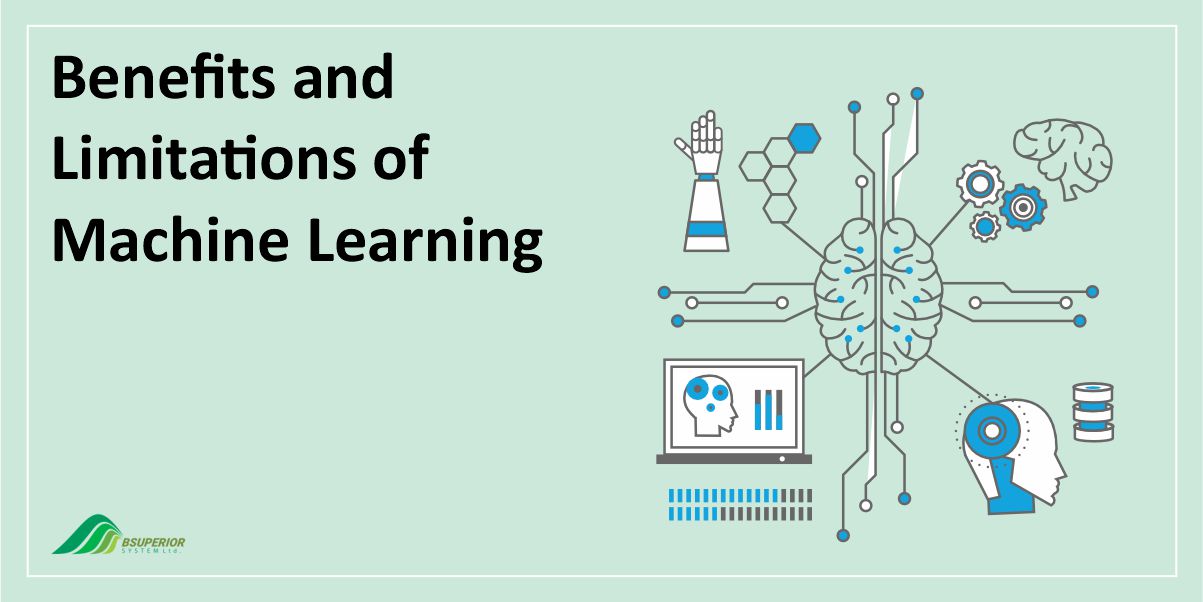Benefits and Limitations of Machine Learning

Table Of Content
Machine Learning is regarded by many as an innovative technological solution that has enabled various businesses to streamline their processes and optimize their operations.
However, similar to any other technology in today’s world, machine learning comes with both advantages and shortcomings.
In what follows, we’re going to explain the key principles of machine learning, and then discuss several benefits and limitations of this technology that you need to consider.
Understanding Machine Learning
Before talking about the benefits of machine learning, it is a good idea to explain what machine learning is and what it involves.
A Definition of Machine Learning
Machine learning (ML) is a subfield of artificial intelligence (AI) that uses data to enhance its capabilities over time.
The main purpose of ML is to provide machines with the ability to autonomously acquire knowledge from data. This allows them to recognize patterns and make predictions or decisions based on the information they have processed.
In contrast to traditional programming with predefined instructions, ML algorithms learn from the data itself, and based on that, uncover relationships and structures that may not be readily apparent to humans.
How Machine Learning Works
Machine learning follows a general workflow that consists of three main stages: data collection, data pre-processing, and model training.
- Data Collection: To begin with, data from various sources, such as databases, websites, and other online repositories are collected.
- Data Pre-processing: The collected data may require cleaning and transformation to make it suitable for the machine learning algorithm. This usually involves handling missing values, formatting inconsistencies, or removing outliers.
- Model Training: In this stage, a machine learning model is trained by using the prepared data.
This involves selecting an appropriate algorithm, configuring its parameters, and then running it on the dataset. The model then learns from the data and improves its ability to perform a specific task.
Read more: What is Machine Learning and How does it relate to small business?
Types of Machine Learning
There are several approaches to machine learning which are grouped according to the nature of the data and the desired outcomes.
1. Supervised Learning
This is a widely used approach where the model is trained via using the data that has already been labeled or categorized. The goal here is to make use of this data to teach the model to accurately predict the desired outcome for new and unseen data sets.
Supervised learning is different from other types of ML in that the model receives a set of training data where the intended outcome is already known.
This allows the model to learn how to achieve the desired result by fine-tuning its internal parameters until it achieves a high degree of accuracy.
2. Unsupervised Learning
The second type of ML is called Unsupervised Learning which comes into play when you have a substantial amount of data without specific instructions on how to use it.
In unsupervised learning, the computer receives unlabeled data without predefined outcomes. The main objective is to identify hidden patterns and groupings within the data that are not immediately apparent to humans.
Unlike the other types of machine learning, unsupervised learning does not provide the computer with target outcomes to achieve. Instead, the computer must autonomously determine the desired results.
3. Reinforcement Learning
As the third category of ML, Reinforcement Learning is used to train agents, including computer programs or robots, to make decisions within complex environments.
In reinforcement learning, the model, which is often comprised of artificial neural networks, receives feedback based on its actions. The goal is to learn how to perform tasks effectively by maximizing rewards and minimizing penalties.
Rather than predicting a specific target outcome, reinforcement learning optimizes a particular outcome. This feature makes it well-suited for scenarios where the correct action is not always obvious
Benefits of Machine Learning
It is clear that ML offers various businesses and organizations a number of important benefits. We will discuss some of these advantages below.
Data-Driven Decisions
ML allows businesses to extract valuable insights from extensive data. By examining historical and real-time data, companies can discover hidden patterns, trends, and connections that are not possible using conventional approaches.
These insights contribute to informed decision-making and enable companies to strategically choose their actions based on evidence derived from data.
Process Automation
Another benefit of ML is that it facilitates the automation of processes. In fact, ML models enable processes to adapt quickly without the need for human intervention.
Moreover, over time, these machine learning algorithms can enhance their performance as a result of a continuous influx of data.
Efficiency and Speed
Thanks to ML, automating tasks that traditionally required significant human time and effort becomes more achievable. ML algorithms can process substantial data volumes and conduct complex tasks at a considerably faster pace compared to humans.
Customer Experience Personalization
Given that ML algorithms are adept at analyzing customer behavior and preferences, they help businesses tailor experiences for individual customers.
To give you some examples, we can mention targeted marketing campaigns, product recommendations, and customized customer service interactions. By catering to these individual needs, companies will be able to improve customer satisfaction and loyalty in a more effective manner.
Predictive Analysis
Predictive analytics is another valuable application of machine learning that enables businesses to forecast future trends and outcomes.
By analyzing historical data, machine learning models can predict not only customer behavior but also product demand and market trends.
This foresight provides businesses with the means to make data-driven decisions and strategically adapt their approaches.
Read More: Internet of Things (IoT) in Supply Chain: Benefits and Challenges
Broad Applicability
Machine learning offers numerous benefits across a wide range of fields. In the commercial sector, it can be used by both e-commerce retailers and healthcare providers to deliver more personalized customer experiences, helping them reach the most relevant target audiences.
Furthermore, ML has demonstrated significant value in academic settings, where it aids in data analysis and compilation for various research projects.
Fraud Detection
Detecting fraudulent activities is crucial for various organizations, particularly financial institutions such as banks that issue credit cards.
Machine learning algorithms analyze behavioral patterns and spending habits to flag potential instances of fraud, including credit card theft and insurance scams.
These same analytical processes and pattern recognition techniques can also be valuable for identifying fraudulent messages and addressing other security-related concerns.
Disadvantages of Machine Learning
Now that you have learned what ML is and what benefits it provides businesses with, you might be wondering whether it has any negative aspects. To answer this question, we must say that just like any other technology, ML is not without disadvantages. Let’s learn more about this.
Initial Costs
One notable disadvantage is the initial costs and resource requirements. Implementing machine learning solutions involves substantial investments in technology, infrastructure, and skilled personnel.
What’s more, developing and training machine learning models demands specialized expertise, and companies must allocate resources for data acquisition, cleaning, and preparation.
That’s why, taking advantage of machine learning solutions might not always be the best choice, particularly for smaller businesses.
Data Dependence and Potential Biases
Machine learning models are highly reliant on the quality and quantity of data they are trained on. Using limited or biased datasets can thus lead to biased predictions.
For example, an algorithm trained on an insufficient dataset will display irrelevant advertisements to customers. Errors introduced through biased data can propagate through the system and remain undetected for extended periods.
Data Privacy and Security Risks
ML’s dependence on data raises concerns about privacy and security. Businesses must prioritize responsible data handling practices to make sure that the customer data is protected.
However, the potential for data breaches and unauthorized access to sensitive information remains an important drawback when it comes to implementing machine learning solutions.
Interpretability of Results
Another disadvantage that comes with the use of machine learning is the ability to understand how machine learning models arrive at their results.
This lack of transparency makes it quite tricky to trust or explain the model’s decisions, especially for complex algorithms.
Which Careers Involve Machine Learning?
The rapid growth of ML and its potential for innovation has attracted many professionals to the field. Beyond the well-known role of Machine Learning Engineer, there are other career options that use machine learning expertise.
We have summarized a number of career paths that involve ML in the table below.
| Career Path | Description |
| Machine Learning Engineer | Designs, implements, and optimizes machine learning models. Analyzes data to uncover trends and make predictions that benefit businesses. |
| Data Scientist | Analyzes and interprets complex data to extract insights and inform business decisions. Uses machine learning algorithms to identify patterns and build predictive models. |
| Data Engineer
|
Builds and maintains the infrastructure that supports machine learning and data analysis. Manages data pipelines and ensures data accessibility and reliability. Works with data scientists and machine learning engineers. |
| Robotics Engineer | Develops robots’ capabilities such as computer vision using machine learning. May also design algorithms to process robot-generated data. |
| Cybersecurity Analyst | Analyzes data to identify vulnerabilities and threats to a company’s digital infrastructure. May develop or improve algorithms used for cybersecurity purposes. |
Final Words
As we highlighted above, ML provides businesses with a number of significant advantages. However, companies must also be aware of the potential pitfalls and should take them into account before implementing any machine learning solutions.
While machine learning holds great potential, grasping its intricacies can be quite challenging, especially for those without a background in statistics or programming. This is where BSUPERIOR can be your guide.

Our team of experts offers comprehensive training and tutorials designed to either introduce you to the fundamentals of machine learning or refine your existing implementation.
If you’re interested in taking advantage of ML to elevate your business efficiency, contact BSUPERIOR today to learn more about our solutions.
We value your input and believe this content may enhance our services. However, it's under review. If you see room for improvement, please use the "Report an issue" button below. Your feedback helps us excel.
Contact us today at –– and speak with our specialist.




